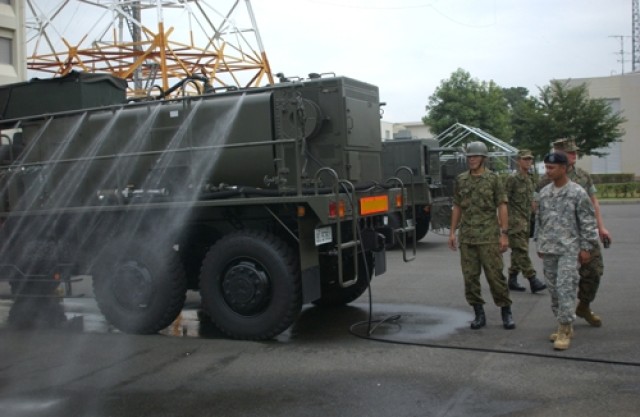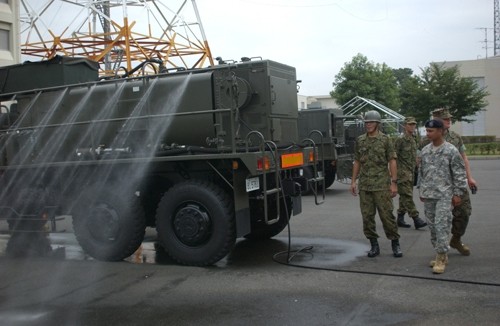Five Soldiers from Camp Zama and six Marines from Camp Hanson in Okinawa toured Japan Ground Self Defense Force's largest chemical unit Aug. 24 at Camp Omiya in the Saitama Prefecture, located northeast of Tokyo, during a 4-day Combined Arms Live Fire Exercise.<br/><br/>The main mission of the JGSDF 101st Chemical Defense Unit is to support nuclear biological and chemical defense and post-disaster restoration.<br/>In March 1995, a terrorist cult Aum Shinlikyo attacked subway commuters in Tokyo with nerve gas, killing 12 people and injuring 5,500, according to a brief given by Capt. Takehiro Nakamura, S3 operation staff of U.S. Army Japan.<br/><br/>The unit's mission is to detect contamination, provide medical support and evacuate survivors. Nakamura's brief also included information regarding the history of the unit, mission and equipment.<br/><br/>"This tour is part of JGSDF public relations activity to develop a good relationship between U.S military and JGSDF," said Nakamura. "This is also a good opportunity to share some of the information we have, especially regarding chemical terrorism, which our unit has actually experienced in 1995. I hope we can offer some good advice from the attack."<br/><br/>Some of the main equipment exhibited during the tour include:<br/><br/>* Nuclear Biological and Chemical (NBC) Recon vehicle mount variety of detection and measurement equipments that accurately and rapidly figure out the NBC contamination<br/><br/>* Decon vehicle mount decontamination system and water heater. It applies to large-scale decontamination. It can also be used as water supply vehicle and water dissenminator in the field.<br/><br/>* Decon system disseminate water or decontaminant to personnel and equipment that contaminated by NBC agents.<br/><br/>"We have visited some different places in this tour including Camp Nerima, Camp Utsunomiya, Camp Asaka, Camp Fuji and here," said 1st Lt. Ann Teragawa, S-1 of 78th Signal Battalion, U.S. Army Japan. "I think we had the most interaction in this unit. They actually let us touch the equipments and show us in detail. All the places we visited had a good briefing, too. I appreciate this opportunity."<br/><br/>The 4-day training tour also included a visit to the Surface Ship Missile Regiment at Camp Utsunomiya in the Tochigi Pref.<br/><br/>"JGSDF were very kind enough to show us around and took good care of us all the time in this tour, said Sgt. Joshua Cruz, customer support NCOIC for USARJ 78th Signal Battalion. " It was nice to spend four days with JGSDF."
NEWS: Soldiers, Marines visit JGSDF chemical unit
By Tetsuo Nakahara , Torii StaffSeptember 17, 2006




Social Sharing